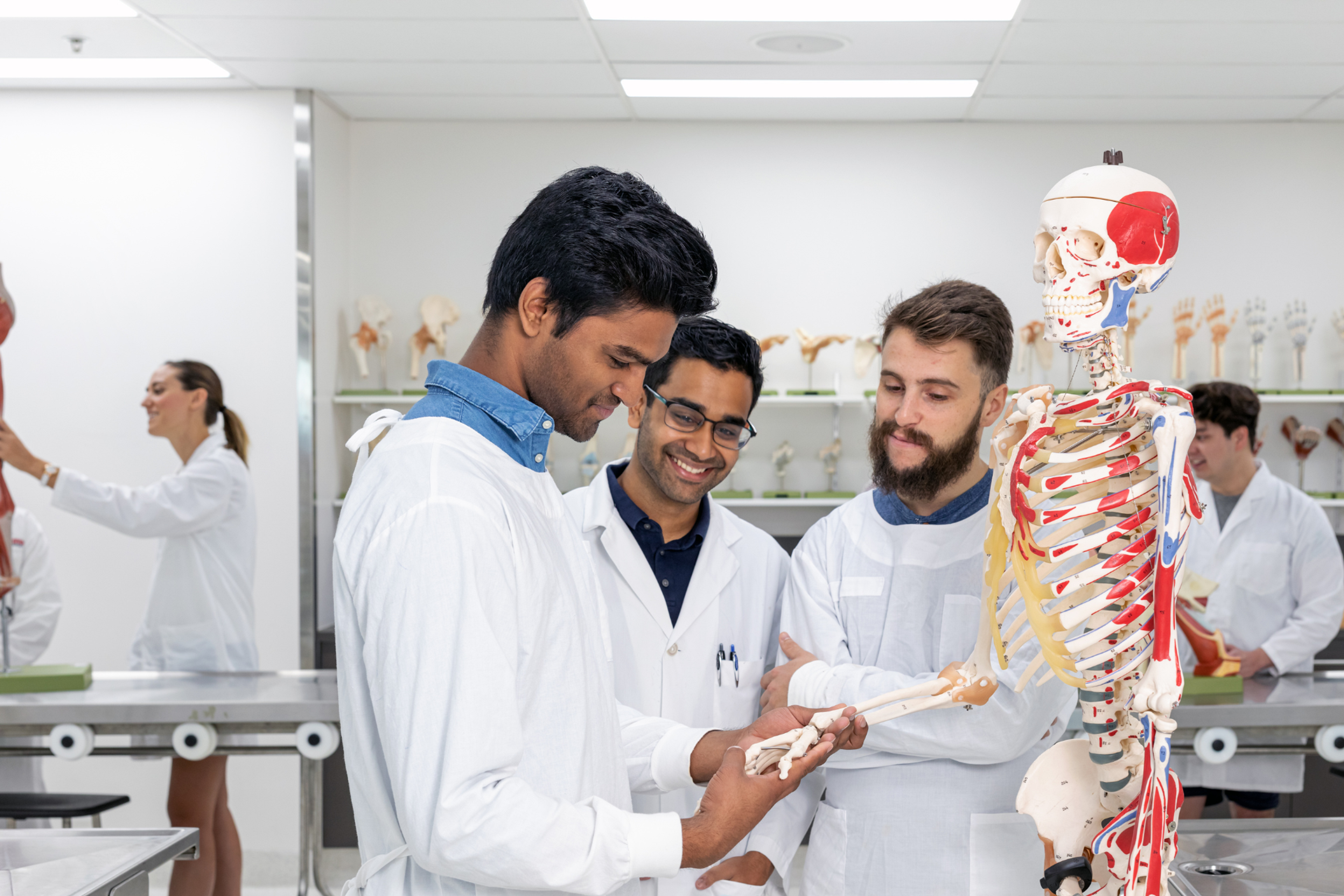The Best DO (Osteopathic) Medical Schools in the US
Learn about the best DO schools in the U.S. with our comprehensive guide featuring rankings, stats, and expert tips to help you find your perfect fit.
Posted April 9, 2025

Table of Contents
Pursuing a career in osteopathic medicine can be a rewarding journey for those passionate about holistic approaches to healthcare. In this comprehensive guide, we’ll explore the best DO schools, factors to consider when choosing a program, and tips for getting accepted. By the end, you’ll know how to select the right osteopathic med school for your career goals.
Read: What is a DO Degree? A Comprehensive Guide to Osteopathic Medicine
What Is a DO Degree and How Is It Different from an MD Degree?
A Doctor of Osteopathic Medicine (DO) degree differs from an MD (Doctor of Medicine) degree in its approach to patient care. While both types of medical schools prepare students to become licensed physicians, DO programs emphasize holistic care, preventive medicine, and osteopathic manipulative treatment (OMT). OMT involves using hands-on techniques to diagnose, treat, and prevent illness, focusing on the body’s ability to heal itself.
DO schools focus on training students to view the body as an interconnected system rather than isolated parts. This philosophy aligns with osteopathic principles, which stress the importance of treating the whole person. In contrast, MD schools tend to focus more on diagnosing and treating specific symptoms. Both types of schools offer rigorous medical education, but DO programs often place greater emphasis on primary care and preventive medicine.
History and Evolution of Osteopathic Medicine
Osteopathic medicine traces back to the late 19th century when Dr. Andrew Taylor Still founded the first osteopathic medical school in Missouri. His philosophy was rooted in the belief that the body has the inherent ability to heal itself when properly aligned and balanced. Since then, osteopathic medicine has grown significantly, and today, DOs are fully licensed physicians practicing in all 50 states.
In the US, there are over 30 accredited osteopathic medical schools, producing graduates who excel in primary care specialties, rural areas, and underserved communities. DOs often practice as primary care physicians, but they can also specialize in various fields, from sports medicine to addiction treatment.
Top 10 DO Schools in the United States
After thorough research and analysis, here are the top DO schools in the US:
| Rank | School Name | Location | Year Established | Annual Tuition & Fees | Avg. GPA | Avg. MCAT | Acceptance Rate | Description |
|---|---|---|---|---|---|---|---|---|
| 1 | Michigan State University College of Osteopathic Medicine (MSUCOM) | East Lansing, MI | 1969 | $47,087 (in-state); $65,631 (out-of-state) | 3.6 | 506–508 | 5.5% | MSUCOM emphasizes patient-centered care and offers extensive clinical training across various specialties, with a strong commitment to producing primary care physicians serving in underserved areas. |
| 2 | Ohio University Heritage College of Osteopathic Medicine (OU-HCOM) | Athens, OH | 1975 | $38,564 (in-state); $53,180 (out-of-state) | 3.68 | 503.5 | 9.1% | OU-HCOM focuses on training physicians for Ohio's rural communities, integrating osteopathic principles with preventive medicine and primary care specialties. |
| 3 | West Virginia School of Osteopathic Medicine (WVSOM) | Lewisburg, WV | 1972 | $63,113 (in-state); $95,913 (out-of-state) | 3.52 | 497 | 9% | WVSOM specializes in rural medicine, providing extensive clinical experience in underserved areas and consistently ranking highly for its commitment to rural health education. |
| 4 | Midwestern University Arizona College of Osteopathic Medicine (AZCOM) | Glendale, AZ | 1995 | $81,456 | 3.48 | Not specified | 15% | AZCOM offers comprehensive medical training with diverse clinical rotations, known for its innovative curriculum and hands-on learning opportunities in primary care and osteopathic manipulative treatment. |
| 5 | University of New England College of Osteopathic Medicine (UNE COM) | Biddeford, ME | 1978 | $69,220 | 3.57 | 504 | 20% | UNE COM integrates osteopathic principles with modern medical education, focusing on primary care, preventive medicine, and rural health, emphasizing treating the whole person. |
| 6 | Western University of Health Sciences College of Osteopathic Medicine of the Pacific (WesternU COMP) | Pomona, CA | 1977 | $68,763 | 3.49 | Not specified | 20% | WesternU COMP is known for diverse clinical experiences and an interdisciplinary approach, offering extensive rotations across various states, preparing students for specialties including primary care. |
| 7 | Nova Southeastern University Dr. Kiran C. Patel College of Osteopathic Medicine (NSU-KPCOM) | Fort Lauderdale, FL | 1979 | $67,513 | 3.71 | 504 | 17.1% | NSU-KPCOM combines traditional osteopathic principles with modern practices, offering strong clinical training with a focus on primary care, research, and community health. |
| 8 | Rocky Vista University College of Osteopathic Medicine (RVUCOM) | Parker, CO | 2006 | $66,604 | 3.56 | 504.4 | Not specified | RVUCOM emphasizes primary care and rural health, offering rigorous training in osteopathic manipulative medicine and encouraging practice in underserved communities. |
| 9 | Des Moines University College of Osteopathic Medicine (DMU-COM) | Des Moines, IA | 1898 | $66,300 | 3.71 | 507 | 16% | DMU-COM is renowned for its preventive medicine curriculum and holistic patient care approach, offering advanced clinical training with rotations in various specialties. |
| 10 | A.T. Still University Kirksville College of Osteopathic Medicine (ATSU-KCOM) | Kirksville, MO | 1892 | $64,938 | 3.61 | 502 | 9% | As the oldest osteopathic medical school, ATSU-KCOM has a long-standing reputation for excellence, emphasizing innovative teaching methods and extensive training in osteopathic manipulative treatment. |
Additional Notable DO Medical Schools to Consider
In addition to the top-ranked DO programs, several other osteopathic medical schools offer excellent training and unique specializations. Prospective medical students should consider the following osteopathic medical schools known for their contributions to primary care, rural health, and innovative medical education.
1. William Carey University College of Osteopathic Medicine (WCUCOM)
Located in Hattiesburg, Mississippi, William Carey University College of Osteopathic Medicine is dedicated to producing physicians who will practice in underserved areas throughout the Gulf South region. The school emphasizes a holistic approach to patient care, preventative medicine, and clinical training tailored to rural and primary care settings. It’s known for providing strong clinical rotations and a supportive educational environment.
2. Alabama College of Osteopathic Medicine (ACOM)
As the first osteopathic medical school in Alabama, the Alabama College of Osteopathic Medicine focuses heavily on training physicians to serve in rural and medically underserved areas. Located in Dothan, ACOM is renowned for its commitment to providing high-quality medical education with an emphasis on primary care specialties. Its partnerships with regional healthcare facilities enhance clinical training and residency opportunities for its graduates.
3. Pacific Northwest University of Health Sciences College of Osteopathic Medicine (PNWU-COM)
Situated in Yakima, Washington, Pacific Northwest University College of Osteopathic Medicine focuses on addressing healthcare disparities in the rural and medically underserved areas of the Pacific Northwest. PNWU-COM offers an innovative curriculum that integrates osteopathic principles with modern medical practices, preparing graduates for a wide range of residency programs and specialties.
4. Lake Erie College of Osteopathic Medicine (LECOM)
With campuses in Pennsylvania, Florida, and New York, Lake Erie College of Osteopathic Medicine is one of the largest and most comprehensive osteopathic medical schools in the nation. LECOM offers a diverse range of programs and pathways, including primary care, osteopathic manipulative medicine, and clinical research. The school’s extensive clinical network provides students with valuable opportunities for clinical experience and residency placements.
5. University of Pikeville Kentucky College of Osteopathic Medicine (UP-KYCOM)
Located in Pikeville, Kentucky, the Pikeville Kentucky College of Osteopathic Medicine focuses on producing primary care physicians for rural and underserved areas in the Appalachian region. UP-KYCOM emphasizes osteopathic manipulative treatment (OMT) and preventive medicine while providing robust clinical training opportunities in community settings.
Accreditation and What It Means for DO Students
The Commission on Osteopathic College Accreditation (COCA) is responsible for accrediting osteopathic medical schools. Accreditation ensures these schools meet rigorous academic and professional standards. It's essential to verify a program’s accreditation status since graduates of unaccredited schools are not eligible for licensure in the United States.
COCA’s accreditation process is ongoing, requiring schools to maintain quality education standards through regular reviews. Accreditation also plays a crucial role in ensuring high-quality clinical training and preparation for residency programs.
Factors to Consider When Choosing a DO School
When evaluating osteopathic medical schools, it's essential to thoroughly assess various aspects to ensure you select a program that aligns with your career goals and personal preferences.
Accreditation
Ensure that the program is accredited by the Commission on Osteopathic College Accreditation (COCA). Accreditation guarantees that the school meets rigorous academic and professional standards, which is essential for eligibility to practice as a licensed physician in the United States. Top-tier schools such as Michigan State University College of Osteopathic Medicine and Des Moines University College of Osteopathic Medicine hold full accreditation, reflecting their commitment to providing high-quality medical education.
Location
Geographical location can significantly influence your medical education experience. Some schools excel in training physicians for specific environments. For instance, the West Virginia School of Osteopathic Medicine is renowned for its rural health training programs, which are particularly valuable for students interested in practicing in underserved or rural areas. Additionally, considering the proximity to hospitals, clinics, and research facilities can enhance your clinical training and networking opportunities.
Clinical Experience
The extent and quality of clinical experience offered by a DO program are pivotal to your medical training. Schools like Michigan State University College of Osteopathic Medicine provide hands-on training from the beginning, ensuring students gain practical experience across various medical specialties. Comprehensive clinical rotations are especially valuable for developing your skills and preparing for residency programs.
Residency Programs
Evaluating a school’s residency match rates and the variety of primary care specialties offered is essential. High match rates indicate strong preparation and support for students pursuing competitive residencies. Programs like Ohio University Heritage College of Osteopathic Medicine and Des Moines University College of Osteopathic Medicine consistently achieve high match rates in primary care specialties, making them excellent options for students focused on this career path.
Campus Culture
Understanding a school’s campus culture is crucial to ensuring you feel comfortable and supported throughout your medical education. Each DO school has a unique atmosphere shaped by its curriculum, faculty, student body, and institutional philosophy. For example, Still University emphasizes community-oriented care, which may appeal to medical students seeking a collaborative, service-oriented environment. Researching student testimonials and visiting campuses can provide valuable insights into what daily life at each school might be like.
Research Opportunities
Research opportunities are another essential factor to consider, particularly if you are interested in osteopathic manipulative medicine or other specialized fields. Schools like Western University of Health Sciences excel in providing cutting-edge research opportunities, allowing medical students to contribute to advancements in osteopathic medicine. Engaging in research can enhance your residency applications and deepen your understanding of medical science.
Read: How to Decide Where to Apply for Graduate School
Admissions Requirements for Top DO Schools
Admission to a DO program typically requires:
- Bachelor’s Degree - Applicants must hold a bachelor’s degree with a strong science background, including coursework in biology, chemistry, physics, and often biochemistry.
- MCAT Scores - Competitive MCAT scores are required, typically ranging between 500 and 510 for admitted students at top programs.
- GPA - A minimum overall GPA of 3.4 and a science GPA above 3.2 are commonly expected for admission.
- Clinical Experience - Applicants should have significant clinical experience through shadowing, volunteering, or working in healthcare settings.
- Commitment to Osteopathic Principles - Demonstrating knowledge of osteopathic principles, preventive medicine, and holistic care is essential.
- Letters of Recommendation - Most schools require at least three letters, including one from a practicing DO to verify commitment to osteopathic medicine.
- Extracurricular Activities and Leadership - Participation in research, community service, and leadership roles can strengthen applications.
- Interview Process - Schools assess interpersonal skills, professionalism, and motivation during interviews, which are a critical part of the admissions process.
Read: Mastering Medical School Interviews: Questions and Strategies
Make the Right Choice with The Help of Experts!
Choosing the right osteopathic medical school can be daunting, but top medical school coaches provide invaluable guidance. They help you research schools like William Carey University College of Osteopathic Medicine, Alabama College of Osteopathic Medicine, and Pacific Northwest University to find the best fit. Coaches assist with crafting strong applications, preparing for interviews, and articulating your commitment to osteopathic principles and preventive medicine. Their expertise can significantly boost your chances of securing admission to a top DO school.
FAQs
What is the easiest osteopathic medical school to get into?
- William Carey University College of Osteopathic Medicine, Lincoln Memorial University Debusk College of Osteopathic Medicine, and Alabama College of Osteopathic Medicine are among some of the easiest osteopathic schools to get into. Which medical schools have the highest acceptance rates?Schools in the US
How many schools of osteopathy are there in the US?
- There are currently 42 accredited colleges of osteopathic medicine in the United States. These colleges are accredited to deliver instruction at 67 teaching locations in 36 states.
Is MD more prestigious than DO?
- No, both DO and MD degrees are equivalent accreditations and provide the same level of authority and responsibility to practice medicine. The main difference between the two is the philosophy and approach to medicine they bring to their practice.
How much does a doctor of osteopathic medicine earn in the USA?
- The estimated total pay for a Doctor of Osteopathic Medicine is $276,469 per year, with an average salary of $222,896 per year. These numbers represent the median, which is the midpoint of the ranges from our proprietary Total Pay Estimate model and based on salaries collected from our users.
What is an osteopath called in the USA?
- A doctor of osteopathic medicine, also known as a D.O., is a fully trained and licensed doctor. A doctor of osteopathic medicine graduates from a U.S. osteopathic medical school. A doctor of medicine, also known as an M.D., graduates from a traditional medical school.












